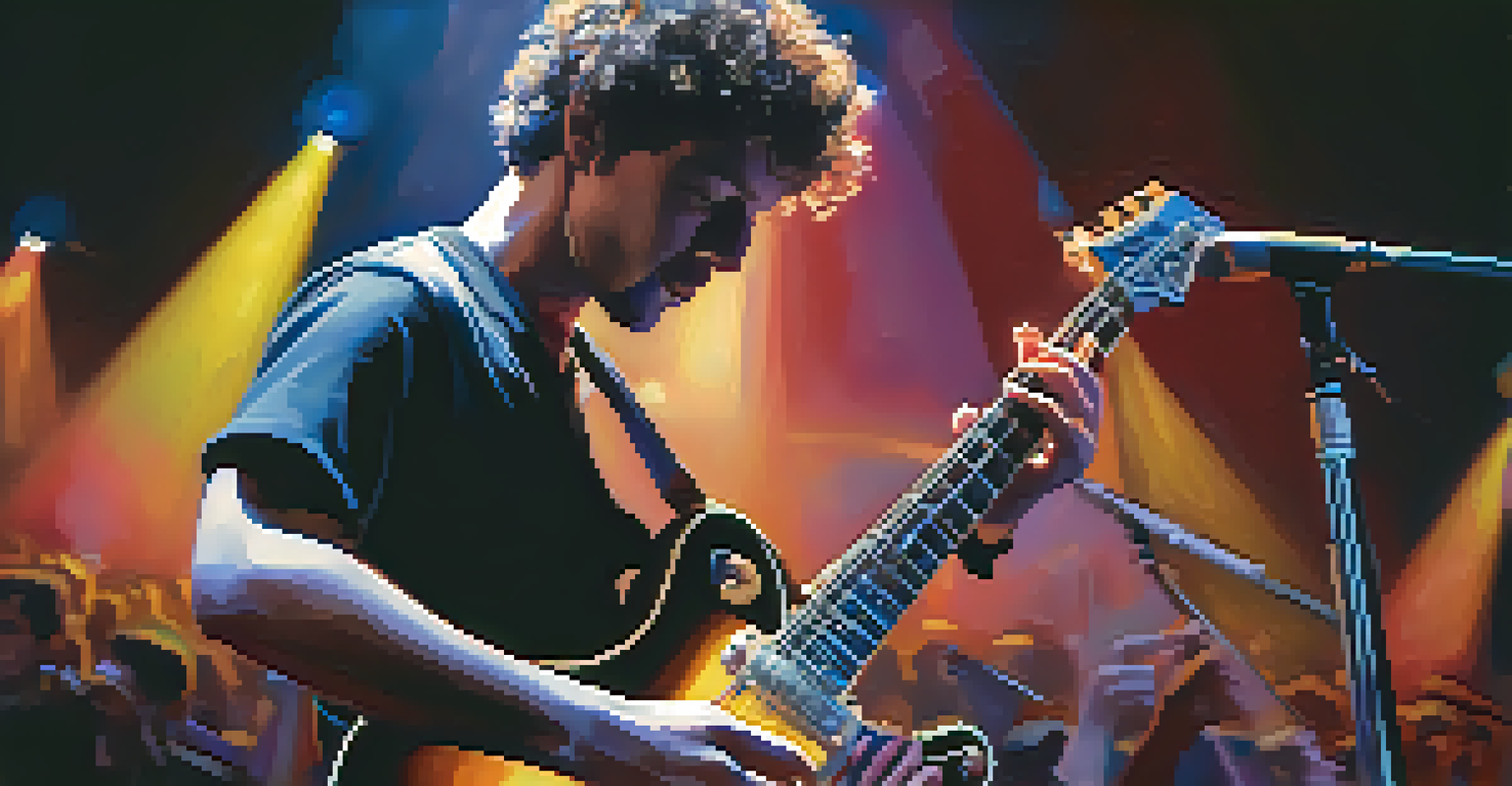Analyzing Great Songs: Guitar Techniques to Learn From

Strumming Patterns: The Backbone of Great Rhythm
Strumming patterns are essential in creating the rhythm of a song. They provide the pulse that drives the music forward, keeping everything in sync. For example, think about how the upbeat strumming in 'Riptide' by Vance Joy instantly sets a cheerful tone, inviting listeners to tap their feet along.
Music can change the world because it can change people.
By studying various strumming techniques, you can add a unique flavor to your playing. For instance, alternating between downstrokes and upstrokes can create a more dynamic sound. This approach can be heard in songs like 'Wonderwall' by Oasis, where the strumming pattern plays a significant role in its catchy appeal.
Practicing different strumming patterns will not only enhance your timing but also improve your overall musicality. As you experiment, you’ll discover how a simple change in rhythm can transform a song, allowing you to express your creativity while staying true to the original vibe.
Fingerpicking: Adding Depth and Emotion
Fingerpicking is a beautiful technique that adds depth and emotion to guitar playing. It allows for a more intimate sound, often evoking strong feelings in listeners. Take 'Blackbird' by The Beatles as an example; its delicate fingerpicking creates a serene atmosphere that captivates anyone who hears it.

This technique involves plucking the strings with your fingertips rather than using a pick, giving each note a nuanced quality. By mastering simple patterns, you can unlock a world of beautiful melodies. Songs like 'Dust in the Wind' by Kansas showcase how fingerpicking can create a hauntingly beautiful backdrop to poignant lyrics.
Mastering Strumming Patterns
Strumming patterns are crucial for establishing rhythm and enhancing the musicality of your guitar playing.
To get started with fingerpicking, practice basic patterns and gradually incorporate more complex sequences. As you grow more comfortable, you’ll find your ability to convey emotion through your guitar playing will flourish, enriching both your performances and songwriting.
Hammer-Ons and Pull-Offs: Creating Fluid Melodies
Hammer-ons and pull-offs are techniques that create fluid and connected melodies. These techniques allow you to play notes smoothly without picking each one individually, giving your playing a more sophisticated sound. A great example is 'Sweet Child o' Mine' by Guns N' Roses, where the iconic intro uses hammer-ons to create a flowing line.
The guitar is a miniature orchestra in itself.
To perform a hammer-on, you press down on a string to produce a note without picking it again. Conversely, a pull-off involves pulling your finger off a string to let a lower note ring out. Mastering these techniques can add a level of expressiveness to your solos and riffs, as you can transition between notes seamlessly.
Incorporating hammer-ons and pull-offs into your practice routine can elevate your guitar skills. Start slowly, focusing on accuracy, before increasing your speed. With time, you’ll notice how these techniques can transform your playing, making it more dynamic and engaging.
Bending Notes: Infusing Emotion into Your Playing
Bending notes is a powerful technique that adds expressiveness and emotion to your guitar solos. By pushing the string up or down, you can create a pitch that resonates deeply with listeners. Think about the soulful bends in 'The Thrill Is Gone' by B.B. King; they convey a sense of longing and passion that’s hard to ignore.
This technique can be used to hit notes that are slightly out of tune, adding a unique flavor to your solos. It’s often used in blues and rock music to create a raw and powerful sound. For beginners, practicing bends on the pentatonic scale can be a great way to incorporate this technique into your playing.
Emotional Depth with Fingerpicking
Fingerpicking adds a nuanced quality to your music, allowing for intimate and expressive performances.
As you become more comfortable with bending notes, experiment with different techniques like pre-bends or releasing bends. This exploration will help you find your own voice on the guitar and connect with your audience on a deeper level.
Slides: A Smooth Transition Between Notes
Slides are a fantastic technique that creates smooth transitions between notes, adding a unique flair to your playing. By sliding your finger up or down the fretboard, you can achieve a sound that feels fluid and expressive. The iconic slide in 'Layla' by Eric Clapton is a perfect example of how this technique can elevate a guitar solo.
This technique is not just for solos; it can also enhance your rhythm playing. Slides can add a sense of movement to chords, making them more dynamic. For instance, when playing 'Wish You Were Here' by Pink Floyd, incorporating slides can bring the chords to life, creating a more engaging listening experience.
To practice slides, start with simple movements between adjacent frets and gradually work your way up to longer distances. With time, you’ll find that incorporating slides into your playing will create a richer, more expressive sound that enhances your musical storytelling.
Chords: The Foundation of Many Great Songs
Chords are the building blocks of most songs, providing harmonic support and structure. Understanding how to play various chord shapes can open the door to countless songs. For instance, the simple G-C-D progression is the foundation of many classic hits, making it essential for any aspiring guitarist.
Learning different chord voicings allows you to add texture and color to your playing. By experimenting with open chords, barre chords, and jazz chords, you can discover unique sounds that make your music stand out. Songs like 'Creep' by Radiohead showcase how a few well-placed chords can create an impactful emotional response.
Techniques for Fluid Melodies
Incorporating techniques like hammer-ons, pull-offs, and slides can create smooth transitions and dynamic sounds in your playing.
As you practice transitioning between chords smoothly, you'll develop a strong sense of timing and rhythm. This skill will not only improve your playing but also enhance your ability to accompany singers or other musicians, making you a more versatile guitarist.
Tapping: Adding a Unique Flair to Your Solos
Tapping is an impressive technique that can add a unique flair to your guitar solos. By using your fingers to tap on the fretboard, you can create rapid sequences of notes that sound complex and captivating. Songs like 'Eruption' by Van Halen highlight the power of tapping, showcasing how this technique can elevate your playing to new heights.
This technique allows for fast note sequences that are difficult to achieve with traditional picking. It gives you the ability to play melodic lines in a way that feels effortless. As you practice tapping, you'll find that it enhances your dexterity and coordination, making you a more skilled guitarist overall.

To get started with tapping, focus on simple patterns before progressing to more intricate sequences. The more you practice, the more natural tapping will feel, allowing you to incorporate it seamlessly into your solos and improvisations.